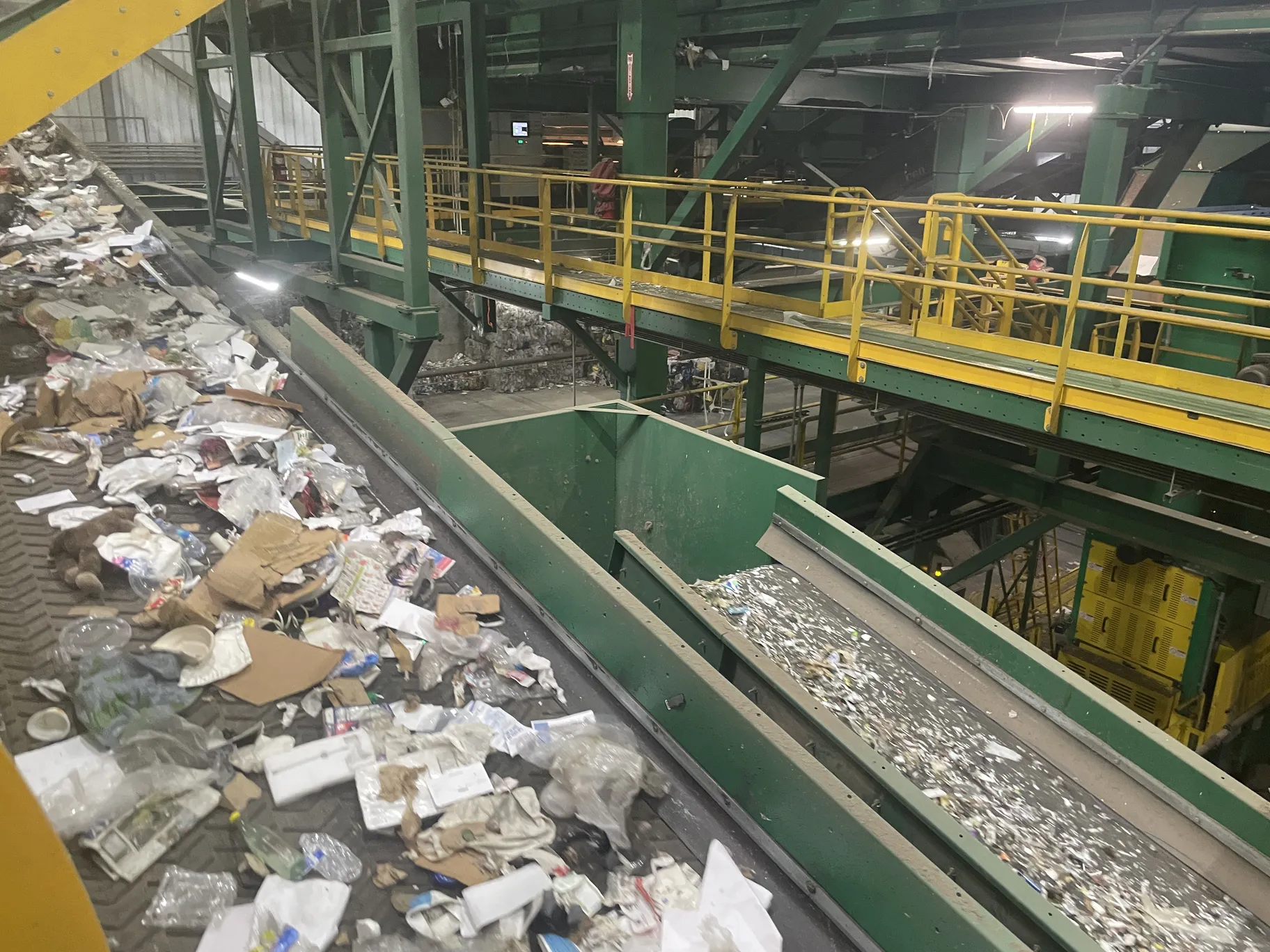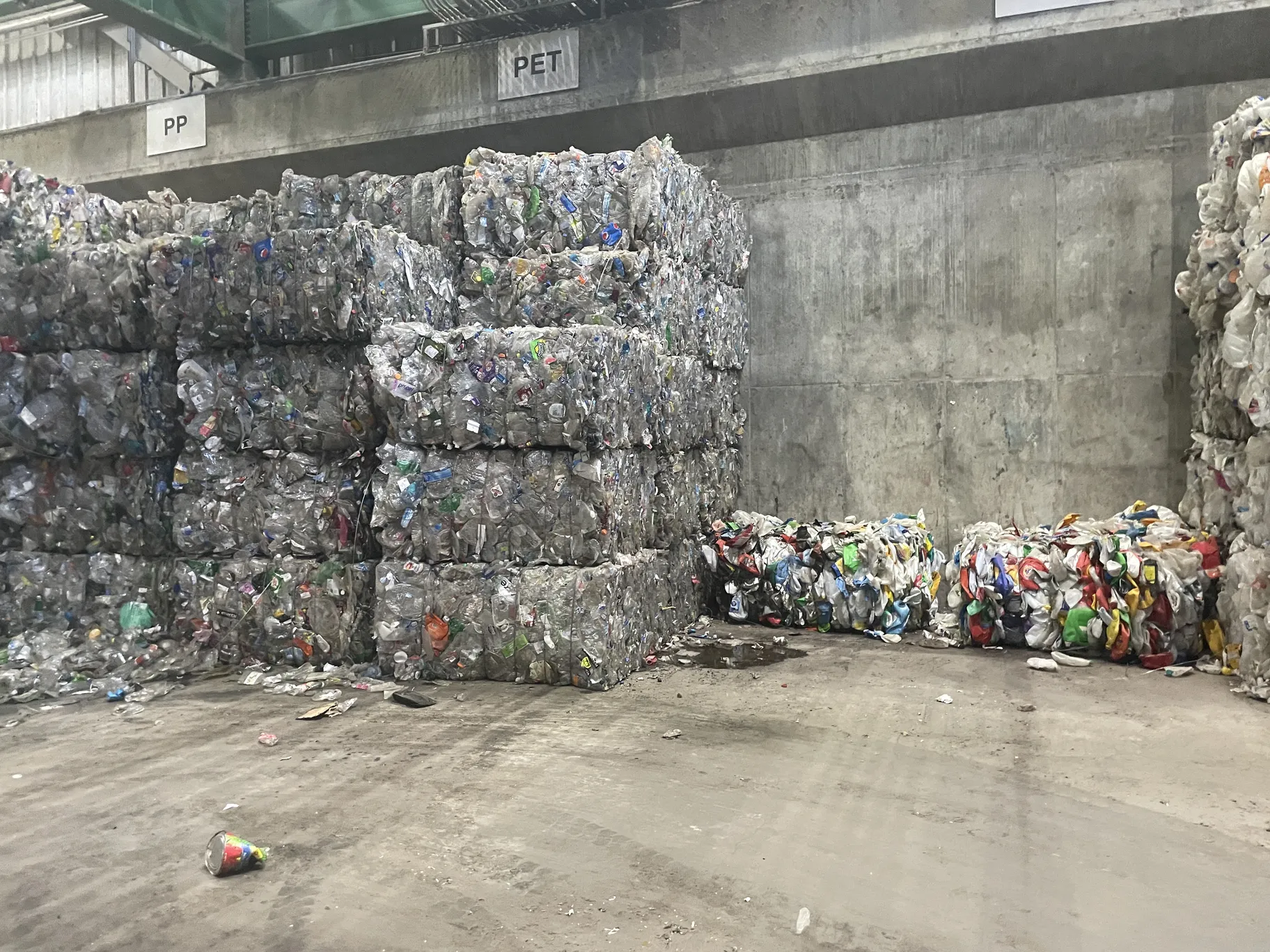“Is recycling really worth the effort?” “What belongs in the blue bin?” “How much do I need to prep my recyclables so they don’t end up as landfill?”
You asked us recycling questions, and we put them to California recyclers, state department leaders and consumer advocates. Now we’re here with the answers.
Let’s start with the big one:
Is recycling really worth the effort?
Easy answer: Yes.
There’s an entire industry devoted to finding another use for all the glass, aluminum, paper, and plastic you drop into the blue bin.
The Waste Management (now known as WM) recycling plant in Sun Valley, for instance, processes the recyclables of 5 million people per day. Every single item that comes from your blue bin gets shuttled onto conveyor belts, picked up by human hands or robot arms, and sorted into shoots and streams, all with the goal of diverting it from landfill.
Aluminum cans can be turned into new cans over and over again. Plastics can get new lives as toys, clothes, carpet, and other items. And cardboard hitches a ride on boats to China so it can become new boxes filled with the stuff we buy online.

The maze of conveyor belts at WM’s recycling plant in Sun Valley shuttle thousands of pounds of recycled material every month. Photo by Caleigh Wells.
What percentage of my blue bin recyclables ACTUALLY gets recycled?
WM estimates that it recycles 70-80% of the items that come through their Sun Valley facility. And of the stuff that’s not recycled, “the vast majority … didn't belong there in the first place,” says WM Southern California President Mike Hammer. He says some common offenders include garden hoses and bowling balls.
The hardest thing to recycle? No surprise: plastic.
“Currently very little of the plastic that consumers buy is recyclable. That is the unfortunate truth of where we are today. And we're producing more and more plastic in our economy every year,” says CalRecycle Director Rachel Machi Wagoner.

The recycling plant's finished products are bales of paper, cardboard, plastics, and aluminum for other companies and sorters to purchase. Photo by Caleigh Wells.
Five years ago, the international market for our recyclables slowed down and our exports of recyclables plummeted. Since then, California has required more domestic use of recyclables and passed a law requiring plastic manufacturers to make more of it recyclable.
Let’s talk about what belongs in the blue bin. Can I recycle my…?
Amazon plastic mailers? No.
Bubble-lined padded envelopes? No.
Clamshell containers from the grocery store? Most likely, no. There’s no harm in checking to see if there’s a recycling symbol with a number in the middle because some are recyclable, but it depends on what your waste hauler accepts. The chance that a plastic clamshell container is recyclable AND is a form of plastic your waste hauler accepts is not high.
Shiny paper like magazines and Christmas wrapping? “Not recyclable at this juncture,” says Wagoner. “Less of that is better. Cancel those subscriptions that you're not using.” Wagoner is also a big fan of the reusable gift bag to avoid unrecyclable wrapping papers. Die-hard gift wrappers can also invest in recyclable matte papers or use newspaper to avoid creating more trash for the landfill.
Ziploc bags? No.
Shredded paper? I mean, you can try. But small bits of paper fall through the machinery and typically don’t get recycled. You dramatically increase the chance it’ll be recycled if you don’t shred it first.
Plastic sleeves the newspaper arrives in? No. But by the way, thanks for supporting local news media. And the paper itself definitely is recyclable, of course.
Ice packs for food deliveries? No.
The bag that my pre-washed salad greens come in? Probably not. Check to see if it’s got a recycling symbol on it with a number in the middle, and then check to see if your recycling system accepts plastics with that number on them. But the odds are low.
What do I do with plastic bags? Some of them say they’re recyclable.
Do NOT put them in your blue bin. Don’t even ball them up and tie them together.
Some stores like Target and Walmart might have a plastic bag dropoff, but there's no guarantee that anything in that bin will get recycled.
“All it does is make you feel good,” says consumer advocate Liza Tucker with Consumer Watchdog. “It makes it sound like this stuff is recyclable, and so you're willing to go and do it, but it does end up either landfilled, incinerated or exported now to countries like India and Indonesia. It's a complete fake. It should be going right into the garbage.”
The best thing to do with plastic bags? Avoid them.
“[Something] better would be never creating that plastic in the first place. Reduction of plastic bags is absolutely what we need to be doing. We need to reduce overall production of plastic in the market, period,” says Wagoner.
Is washing out the peanut butter jar worth it, or is that just a waste of water? How clean does it really have to be?
It’s worth it, but don’t spend a gallon of water making it perfect.
“Just put a little bit of water in the bottle, put the cap back on, shake it, then pour out that water and that’s good enough,” says Tucker.
The guy who’s in charge of the peanut butter jars after they leave your blue bin agrees.
“Don't go overboard and do something so much that you're having a negative environmental impact to try and do something good,” says WM Southern California President Mike Hammer. “The technology can handle it.”
How do I recycle the stuff that is recyclable, but can’t go in the blue bin (i.e. things that say they must be recycled at a commercial facility, #6 styrofoam type stuff, etc.)?
Unfortunately, there is no similar service for recyclable items that your blue bin hauler does not accept.
There are companies that offer to take hard-to-recycle items. But dropoff locations can be limited, some services cost money, and the list of items is not inclusive. If you’re committed to more recycling than your local waste haulers are providing, it requires some research, some patience, and sometimes a financial investment.
Do I have to remove the plastic windows in the paper envelopes, or the tape on the cardboard before putting them in the blue bin?
It depends on the hauler, but to be safe, yes, go ahead and do that. Plastic envelope windows and tape are not recyclable, so they’ll need to be removed at some point.
What’s the best way to recycle electronics, and which ones actually need to be recycled? How do you know where to take it to be done properly?
California lists the places near you that will take your electronics. You can also call your local electronics store to see if they’ll take them, but no guarantees there. The state also has some information on what counts as e-waste. To be safe, contact the place you’re planning to take your e-waste to make sure they take everything you want to bring.
Is it true greasy pizza boxes can’t be recycled? How greasy is greasy? Sometimes there’s just a spot of grease on the box top. Is that okay?
It is true, but the good news is that greasy pizza boxes can now be composted in the green bin! Any amount of grease in the blue bin is bad. Contaminated cardboard can’t be recycled, so you can either remove the greasy parts and recycle the clean parts, or compost all of it.
Is it better to recycle cardboard, or compost it?
“At this juncture with where we are in the system and implementation of recycling and the organics system, I would recommend recycling,” says Wagoner.
However, if the cardboard is already low quality, composting might be the better option. Egg cartons, for example, frequently have already been recycled multiple times, so by the time you’re done with them, the fibers have become difficult to recycle.
How do I maximize the amount of my recyclable trash that gets diverted from landfill?
Recycling redemption centers. The glass containers are less likely to break there, and the cleaner bales sold from redemption centers are more valuable.
“It's staying much cleaner than it would be in the recycling bin. That's the beauty of it,” says Tucker. “You want to sequester containers and keep them clean. And when you do that in a bottle redemption system, that is a really smart way to go. That is actually really helping to cut down energy use, to cut down toxic emissions, to create recycling jobs and all of that.”
You actually GET money if you drop off beverage bottles and cans to these places. The only problem is they’re getting rarer. But here’s a map of the remaining open places.
